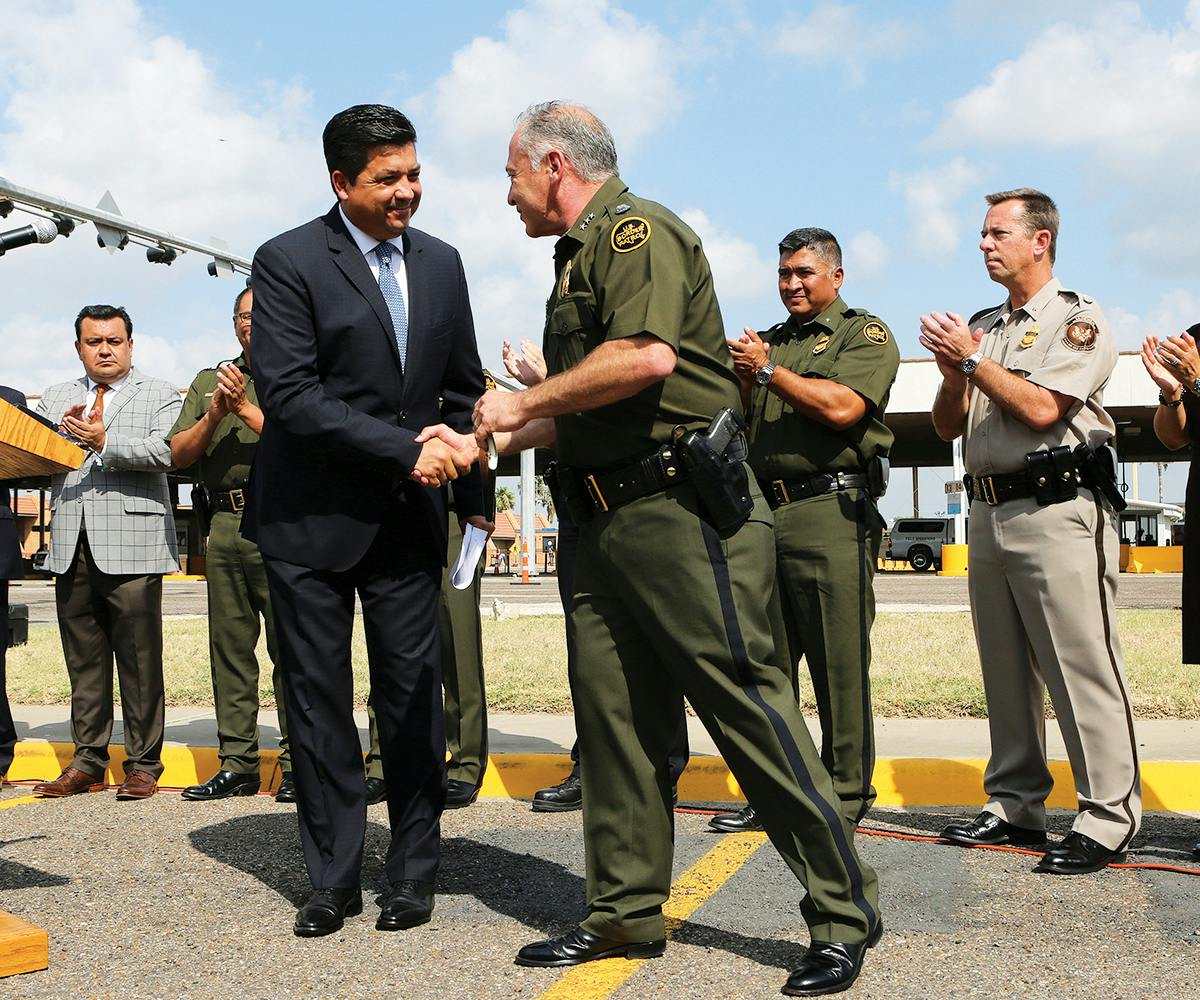Displays of cross-border cooperation are rare in official quarters these days, but here, in the lobby of a federal building in downtown Laredo, a peculiar crowd gathers for a press conference that demonstrates just such a spirit of solidarity. In front of a Mexican flag stands a line of formally dressed American law enforcement officers. Their leader, Manuel Padilla Jr., chief of the United States Border Patrol’s Rio Grande Valley sector—the busiest sector in the country—glad-hands with Francisco Javier García Cabeza de Vaca, the governor of the neighboring Mexican state of Tamaulipas. The two men are here, on September 10, to mark the three-month anniversary of the Campaign for Security and Prosperity, a law enforcement initiative they have shaped together. The CSP aims to increase intelligence sharing and cooperation between Tamaulipas, which has been a hotbed of drug cartel activity, and the U.S. federal government.
“What is good for Mexico is also good for the United States,” García Cabeza de Vaca tells the assembled officers. “And if we work together to guarantee the safety of our citizens, we will achieve the objectives that each and every citizen wants, which is improving the quality of life.” A little later, Padilla agrees. “I’ve been doing this for thirty-two years, and this is the most robust effort I’ve seen along the international border,” he says.
In some ways, the CSP is a run-of-the-mill initiative; its centerpiece is an effort to raise public awareness, primarily by placing billboards with photographs of ten fugitives at major border crossings. If someone—Mexican or American—recognizes somebody on the billboard, they can call or text a hotline number, and the information is then distributed to American agencies and their partners in Mexico. In the first three months of the program’s existence, four people spotlighted on the billboards have been picked up, including alleged Gulf Cartel leader Luis Miguel González Mercado, who was arrested in June.
But the CSP is also unusual, in two respects. First, all of the calls and tips are fielded by U.S. law enforcement. The reason for this is clear: Mexico’s police forces are widely perceived to be corrupt and inefficient. Second, García Cabeza de Vaca is the highest-ranking Mexican official in the room; no one from the Mexican federal government is present. Typically, American federal law enforcement agencies work with Mexican federal law enforcement agencies. The CSP flouts that tradition. Imagine if the Mexican Army made a pact with the Texas Rangers, and you’d get an idea of how odd this arrangement is.
At a time when the border policy set by officials in Mexico City and Washington, D.C., is regarded as erratic, one branch of the U.S. government and one Mexican state are taking matters into their own hands, though not without some controversy. To some observers, the CSP is a promising innovation that offers hope of constraining cartel crime when there are few other prospects. To others, it’s a dangerous violation of national sovereignty that opens a breach between Tamaulipas and the Mexican federal government.
The border between Texas and Tamaulipas accounts for just an eighth of the entire border between the U.S. and Mexico, but it’s a busy stretch of land. More than a third of all of the marijuana and cocaine seized by the Border Patrol along our southern boundary is intercepted here, and more than half of the agency’s apprehensions of migrants occur here as well. The citizens of Tamaulipas pay the price for those illegal activities; they have experienced an extraordinary level of violence in recent years, driven by internecine cartel fighting.
With such violence comes political corruption. Two of García Cabeza de Vaca’s recent predecessors as governor have been charged with laundering money; one of them was also accused of being complicit in the 2010 assassination of another gubernatorial candidate.
García Cabeza de Vaca says he wants to change that. The 51-year-old governor grew up in McAllen, part of a family with extensive business interests on the Mexican side of the border. He attended Houston Baptist University as an undergraduate and got a master’s degree in international commerce at the Universidad de Monterrey. In the late nineties, having settled in Mexico, he joined the conservative National Action Party and worked his way up the political ladder. He served in both chambers of the Mexican legislature and spent one term as the mayor of Reynosa before becoming governor of Tamaulipas, in 2016.
The CSP, he said, was born partly out of frustration over how the border is treated by the Mexican federal government. “National politicians don’t understand that people along the border are not only neighbors, we’re friends, we’re allies, and in many cases we’re family. You need to live it to really understand what goes on on both sides of the border.”
As governor, García Cabeza de Vaca has placed a heavy emphasis on economic development, to which crime is the biggest impediment. Tamaulipas has much unrealized potential. Its ports and its location along the border ought to make it a key beneficiary of international trade, and the state has tremendous untapped energy reserves, in particular the Burgos Basin, an extension of the geological formation responsible for the Texas-side Eagle Ford Shale.
But the first two years of his administration haven’t been encouraging. Murders in early 2018 were up 78 percent compared with the same period the year before, a spike attributed by some observers to the balkanization of the once-unified Gulf Cartel, whose rival cells are fighting among themselves for power. In April and May, the federal government pulled nearly half of its troops from Tamaulipas, where they act as state and local police officers. That same month, Grupo Lala, Mexico’s only nationwide dairy company, closed a distribution center in the state after one of its cargo trucks was burned.
Shortly after, in early June, the Campaign for Security and Prosperity was launched. Because it would be illegal for the state to enter into a formal agreement with agents of the U.S. government, the program was called a campaign, which seems to emphasize its informal, nonbinding elements. It has attracted little attention in Mexico, in part, observers think, because it began just as the hotly contested Mexican presidential race was coming to a close.
“The reason the CSP is important is that many of the organized criminal groups in Tamaulipas have a base in South Texas,” says Tony Payan, the director of the Mexico Center at the Baker Institute at Rice University, who sits on a council that unofficially advises García Cabeza de Vaca. Many of the most serious criminals in Tamaulipas, he claims, are U.S. citizens who live in Texas and fight in the drug wars in Mexico, taking advantage of American legal protections on this side and Mexican lawlessness on the other. Any law enforcement approach that doesn’t straddle the border creates safe havens on the American side.
And because nobody else is effectively dealing with the problem, Payan believes that state politicians have to use whatever tools come their way.

But Guadalupe Correa–Cabrera, an associate professor of policy and government at George Mason University and a global fellow at the Wilson Center who studies transnational organized crime, believes the program is an illegal overreach whose consequences are difficult to predict. Border crime, she says, is a national security issue rightly handled by the nation. The CSP puts sovereignty under threat in part by creating the possibility that state police have better intelligence on national security matters than the federal government does.
The most worrisome element, in Correa-Cabrera’s view, is the hotline itself, which she says cartel members could use as a cudgel against one another. “In such a fragmented state, one [cartel] cell can use the hotline to affect another cell,” she says. “You can use it to get revenge, and you have the risk of innocent people being killed. We don’t really know who is going to use this hotline and where this information is going to go.” (Padilla says, “The information we get, we vet.”)
In the past, Mexican informants working with American law enforcement have helped to inadvertently trigger bloodletting on the southern side of the border. One of the causes of the war that started a decade ago between the Gulf Cartel and Los Zetas was the revelation that some cartel leaders had been supplying information to the American government.
Los Zetas, formerly the Gulf Cartel’s paramilitary arm, split from its parent group and waged a war that cost thousands of lives in Tamaulipas. Today, there are many more criminal organizations jockeying for power. “You take the Gulf Cartel in Reynosa, the Gulf Cartel in Matamoros, the North East Cartel in Nuevo Laredo, the Old School Zetas in Victoria,” Correa-Cabrera says. “And now you have a hotline they can use. You put them more in competition. This is like a call for violence, and there’s going to be more violence. This is really catastrophic.”
Correa-Cabrera believes that García Cabeza de Vaca’s fundamental mission is reassuring investors—that’s why “prosperity” is in the program’s name—rather than protecting the public. And she fundamentally distrusts the governor. “Allegedly, he became the mayor of Reynosa with the agreement of the Gulf Cartel,” she says, echoing public accusations made by some of his opponents in the 2016 gubernatorial race, who charged that the cartel tried to intimidate them during the election.
Though there is no hard evidence that García Cabeza de Vaca is in anyone’s pocket, in July his cousin-in-law was arrested in San Antonio as he attempted to fly $879,099 in concealed bills to Mexico, which his accomplice, who was also arrested, said he did once a week. (Nelson Balido, an ally of the governor who lives in San Antonio, dismisses such insinuations. The cousin, he notes, is a distant relation; American officials vetted García Cabeza de Vaca before starting the CSP; and his recent actions against the cartels are proof of his intent.)
Payan says that though the hotline does offer opportunities for cartel members to target rivals, that’s not entirely a bad thing—cartel members turning on each other is a good development if it gets them off the streets. And since the intel is given anonymously, there’s little chance of retribution against informants. “They may use the hotline to say, ‘Hey, El Mocho is over in that house.’ But how does that detract from the overall mission?” he asks. “A dosage of skepticism is healthy. But I think the governor wants to solve this problem.”
Still, for any of this to work, the CSP will need to maintain Mexican citizens’ trust in American law enforcement. Unfortunately, Mexican popular opinion of the United States is lower than it has been since modern polling on the question began, in 1991. Much of that has do with the words and actions of President Trump, but some of it is tied up with the reputation of the Border Patrol, Tamaulipas’s partner in the CSP. The week after the press conference in Laredo, local police arrested Border Patrol agent Juan David Ortiz for allegedly murdering at least four women. Stories like that color Mexicans’ perception of the Border Patrol, as did the U.S. government’s recent policy on family separations, which Padilla vigorously defended.
“People are not stupid,” Correa-Cabrera says. “They follow the news. They know that this is Trump’s government.” Even Payan says, “A lot of the goodwill is being wasted away. There’s been a needless deterioration of the U.S. image all around.”
The Rio Grande is not a roaring river, but the currents that run through U.S.-Mexico relations are pretty strong these days. To the extent that the Campaign for Security and Prosperity is able to do any good at all, it will be swimming against them.
This article originally appeared in the November 2018 issue of Texas Monthly with the headline “Tamaulipas Calling.” Subscribe today.
- More About:
- Crime
- Border Patrol
- Laredo









